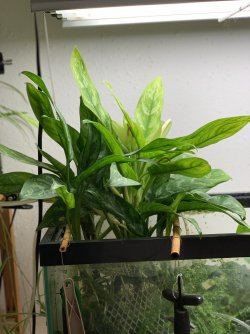You are using an out of date browser. It may not display this or other websites correctly.
You should upgrade or use an alternative browser.
You should upgrade or use an alternative browser.
Pothos in tank
- Thread starter joeyr188
- Start date
most araceae with aerial roots should be able to at least root in the water, and if they reach the substrate most can thrive
pothos should have light or it will have small leaves
just add a calloused cutting to the tank
pothos should have light or it will have small leaves
just add a calloused cutting to the tank
I cite the following. This is not something I would inflict on my fish.
Are pothos plants toxic? The short answer is yes, but let’s talk about why and to whom. Pothos plants are toxic to adults, children, and even pets. While they aren’t typically deadly, pothos plants have an insoluble calcium oxalate crystal within their leaves and stems. These crystals are like shards of glass that will literally rip, tear, and shred the skin. This includes places like the hands, paws, face, mouth, throat, and even digestive system. There have been a few cases, though very rare, where the irritation even causes swelling in the upper part of the airway. This can make it hard to breathe and might be cause for a hospital visit.
Hello joeyr. What's the purpose for the Pothos? If you're wanting to use the plant's root system to help remove the forms of nitrogen from the tank water, this plant isn't the best. Chinese Evergreen will do a much better job. In fact, this plant originated in your part of the country.How should I go about adding pothos to my tank and I there a certain pothos that I can’t do in the tank? Also do they need light?
10 Tanks
WhistlingBadger
Professional Cat Herder
Retired Moderator ⚒️
2x Tank of the Month 🏆
Fish of the Month 🌟

- Joined
- Dec 18, 2011
- Messages
- 7,584
- Reaction score
- 15,281
- Location
- Where the deer and the antelope play
I definitely wouldn't put it with any plant-eaters. For non-plant eaters, it would seem to be fine.I cite the following. This is not something I would inflict on my fish.
Are pothos plants toxic? The short answer is yes, but let’s talk about why and to whom. Pothos plants are toxic to adults, children, and even pets. While they aren’t typically deadly, pothos plants have an insoluble calcium oxalate crystal within their leaves and stems. These crystals are like shards of glass that will literally rip, tear, and shred the skin. This includes places like the hands, paws, face, mouth, throat, and even digestive system. There have been a few cases, though very rare, where the irritation even causes swelling in the upper part of the airway. This can make it hard to breathe and might be cause for a hospital visit.
I have used Pothos roots in tanks, with the leaves and stems above water, for many years. I would not submerge them, and I am careful to keep the roots in, but the stem junction point above water. With room lighting just as you'd need with them in pots, they do really well.
WhistlingBadger
Professional Cat Herder
Retired Moderator ⚒️
2x Tank of the Month 🏆
Fish of the Month 🌟

- Joined
- Dec 18, 2011
- Messages
- 7,584
- Reaction score
- 15,281
- Location
- Where the deer and the antelope play
Looks like Chinese evergreen (Aglaonema modestum) has the same toxicity issue as pothos.Hello joeyr. What's the purpose for the Pothos? If you're wanting to use the plant's root system to help remove the forms of nitrogen from the tank water, this plant isn't the best. Chinese Evergreen will do a much better job. In fact, this plant originated in your part of the country.
10 Tanks

Chinese Evergreen
Chinese Evergreen Are Toxic To Pets. Chewing into this plant will release these crystals causing tissue penetration & irritation to the mouth & oral cavity.
Hello again. Yes, you're correct. That's why you keep the plant in a place your pets are unable to get to. We have seven cats and the tops of the tanks are well out of reach. This means keeping the tank on a stand that displays the tank at eye level. That's about five and half to six feet from the floor. Here's a photo of the "Ag Plant" in a 55 gallon tank.Looks like Chinese evergreen (Aglaonema modestum) has the same toxicity issue as pothos.

Chinese Evergreen
Chinese Evergreen Are Toxic To Pets. Chewing into this plant will release these crystals causing tissue penetration & irritation to the mouth & oral cavity.www.petpoisonhelpline.com
10 Tanks
Attachments
I have used dung onion in tanks before, the snails and fish ate it all and they didn’t get sick
Similar threads
- Replies
- 18
- Views
- 3K
- Replies
- 7
- Views
- 1K

